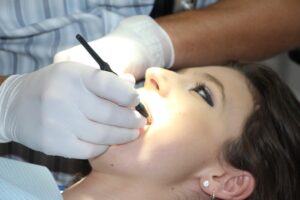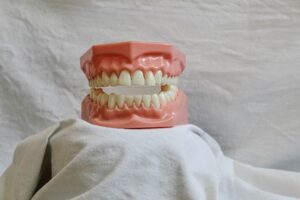Bone Graft
What is a bone graft?
It refers to pre-prosthetic surgery, that bone and / or soft tissue surgery (gingiva) necessary to guarantee the amount of bone required for the placement of dental implants. It is made mandatory when the bone that has to receive the implants does not meet the necessary conditions to guarantee its success.
Titanium dental implants have revolutionized oral rehabilitation for patients with tooth loss. But, to be able to place implants in the mouth, it is necessary to have jaw bones with adequate quantity and bone density. The teeth are housed in the alveolar bone, which is the name of the part of the jawbones that houses the teeth. The alveolar bone remains stable if the teeth are healthy (without periodontal disease) and in function. When we lose our teeth, the alveolar bone that held them is progressively lost, atrophies, as it no longer performs any function or receives mechanical stimuli to maintain it.
The more time that passes since the loss of teeth, the more difficult it is to have adequate bone for the placement of dental implants. At 3 months after the loss of a tooth, bone atrophy is already visible. Detail that in the bone we value 3 characteristics: height, thickness and density. Therefore, 3D images and CT scans are necessary. Patients who do not have the necessary maxillary bone conditions can be rehabilitated with dental implants thanks to bone grafts, combining both surgeries: the placement of dental implants with convenient bone reconstruction.
Typology of Bone grafts
There are different types of bone grafts and techniques to perform them, mainly it is possible to distinguish between the bone graft where the patient is the donor and the synthetic grafts. Both grafts can be combined in the same intervention. Grafts belonging to the patient themselves are the material of choice for the reconstruction of the maxillary bone in oral rehabilitation. In these cases, it must be remembered that there are two “operated” areas in the mouth, the one that gives the bone graft and the one that receives it. Graft harvesting surgery is minimally invasive. Most of the time, bone reconstruction can be done by taking, under local anesthesia, a small amount of bone from another part of the mouth, and then placing it in the area where it is needed for the implant. Bone loss varies from patient to patient, and from one area of the mouth to another. In some patients there is a severe loss of bone and soft tissue of the gum, compromising the final result of the treatment. In these patients, a bone and gum tissue augmentation technique must be performed prior to the placement of the dental implant.
The most common is to perform the dental implant placement, bone reconstruction and gum graft (connective tissue graft) in the same surgical act. This is necessary to achieve a better cosmetic result and to give the implant a better chance of success. Grafts are not necessary for all implants, but they are very often needed in the upper jaw (upper teeth). Thanks to augmentation techniques with grafts, it has been possible to place dental implants in patients who would not initially be considered candidates, due to lack of sufficient bone. When the implants already have the dental prosthesis in place, they will again transmit the forces of chewing to the bone, as if they were natural roots, thus ensuring the preservation of the bone that holds them. Success rates for implants placed in reconstructed bone with bone grafts exceed 90%.
La mayor parte de las veces, se puede realizar la reconstrucción ósea tomando, con anestesia local, una pequeña cantidad de hueso de otra parte de la boca, y colocándola después en la zona donde se necesita para el implante.
La pérdida ósea varía de unos pacientes a otros, y de unas zonas de la boca a otras. En algunos pacientes existe una pérdida severa de hueso y de tejidos blandos de la encía, llegando a comprometer el resultado final del tratamiento. En estos pacientes, debe realizarse una técnica de aumento de tejido óseo y encía previa a la colocación del implante dental.
Lo más habitual es realizar en el mismo acto quirúrgico la colocación del implante dental, la reconstrucción ósea y el injerto de encía (injerto de tejido conectivo). Esto es necesario para conseguir un resultado estético mejor y dar una mejor posibilidad de éxito al implante.
Los injertos no son necesarios para todos los implantes, pero es muy frecuente necesitarlos en el maxilar superior (dientes superiores).
Gracias a las técnicas de aumento con los injertos se ha hecho posible la colocación de implantes dentales en pacientes que no serían considerados inicialmente candidatos, por falta de hueso suficiente.
Cuando los implantes ya llevan la prótesis dental colocada transmitirán de nuevo las fuerzas de la masticación al hueso, como si fuesen raíces naturales, asegurando así la conservación del hueso que los sujeta.
Las tasas de éxito de los implantes colocados en hueso reconstruido con injertos óseos superan el 90%.
Our Recommendations
Why have an operation at Birbe Clinic?
We are specialists in designing faces and smiles.
At Birbe Clinic we have a great team, mentored by Dr. Joan Birbe, with more than 20 years of experience treating patients; always up to date with news and selecting the innovations that really bring improvements to our treatments. As in the case of virtual simulations of facial surgeries, intraoral scanners, customization of facial prostheses, the use of the microscope, etc.
Testimonials
Our priority is to achieve excellence in treatment. All this with a personalized, honest and trustworthy treatment. In addition, our facilities offer maximum hygiene, sterilization and comfort.
Find out what they think of us!
We help you carry out the intervention you need
After a rigorous evaluation we will offer you a personalized and closed estimate with all the necessary forms of payment and financing, so that you can carry it out.
Frequently Asked Questions
Dr. Birbe studies each situation carefully, selects the most suitable graft options to present to the patient and decides on the final rehabilitative treatment.
They are usually treatments that involve a long time, since the healing of the bone takes months and the stabilization of the gingiva as well, therefore planning and good understanding is important before starting the treatment.
The most frequent cause of complications with bone grafts is usually a consequence of the opening of the oral mucosa, with early exposure of the graft to the intraoral environment, bacterial contamination and loss of the graft.
Patients with a smoking habit and poor oral hygiene are at higher risk for complications.
In the upper jaw, it is very common, for aesthetic reasons, to have to thicken the gingiva in the region where the implant is to be placed, by means of a soft tissue graft (connective tissue graft, keratinized gingiva).
It is a minimally invasive surgery that is performed under local anesthesia. We obtain the tissue from the palate or from the region after the wisdom tooth of the upper jaw (maxillary tuberosity).
The use of connective grafts allows to achieve a better aesthetic result of the prosthesis, of the smile, in short; as it prevents the gum from being sunken and in shadow (as if darkened).
This type of graft helps to keep the result stable over the years, reducing the chances of retractions in the gum and exposures of the titanium of the implants.
The upper jaw bone is a pneumatized bone, that is, it has a cavity inside, the so-called maxillary sinus. This fact emphasizes that a bone graft is easily necessary to place implants in the area of the molars of the upper jaw and ensure that they remain well stable.
Sinus lift is a common surgical technique to increase bone height in the posterior area of the upper jaw, invading part of the maxillary sinus space. It may be necessary in both maxillary sinuses or in just one of them. It is performed under local anesthesia. Dental implants can usually be placed in the same surgical session.
Contact Us
Contact us during our business hours of:
- Monday, Thursday and Friday from 8.00h to 16.00h.
- Tuesday and Wednesday from 8.00h to 18.00h.
- Phone Number: +34 93 212 47 37.
Outside of our business hours you can send us a WhatsApp or a form and we will answer you as soon as possible. Being located in Barcelona, we receive patients from all over the national and international territory.
During your first consultation we will provide you with:
✔ Personal diagnosis by oral and facial examination.
✔ Closed estimate with different financing possibilities.




